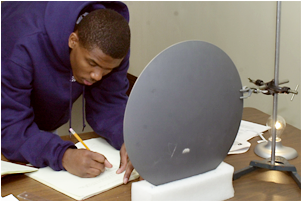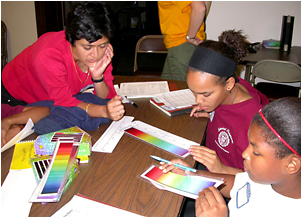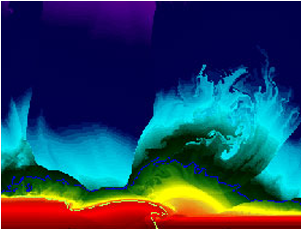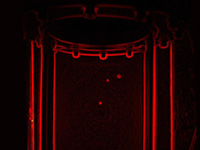 |
 |
 |
 |
 |
 |
 |
 |
 |
 |
|
KICP Workshops & Events
|
KICP Workshops, 2004 What are stars made of?, Yerkes Summer Institute August 7 - 13, 2004 | Yerkes Observatory in Williams Bay, WI Website | Online Materials | Photo Gallery Between summer and the school year the Space Explorers joined members of the KICP at Yerkes Observatory in Williams Bay, WI for a week long investigation into spectroscopy structured around an organizing question, "What are stars made of?" This summer the Space Explorers investigated spectroscopy with the theme: What are stars made of? Through a series of related laboratory explorations the students delved into the fundamentals of spectroscopy and its application to astronomical objects. They studied an assortment of spectra from pure elements and pure food coloring dyes to complex mixtures in solar, stellar and galactic spectra. In some cases the challenge was to produce the spectra and in others to analyze it. Read more >> Related Links: KICP Members: Richard Kessler; Richard G. Kron; Randall H. Landsberg; Erin S. Sheldon; Monica Valluri KICP Students: Carlos E. Cunha; Robert Friedman; Christopher Greer; Sarah M. Hansen; Douglas H. Rudd; Matthew Sharp "Extreme Astronomy @ the Planetarium", Cosmology Short Course September 24 - 26, 2004 | Chicago, IL Website This three-day intensive short course will explore the most violent and mysterious realms of modern astronomy: astronomy of the highest energy phenomena. It will probe the science behind the violent worlds of black holes, neutron stars, active galactic nuclei, supernovae, high energy particles from space, x-ray & gamma-ray bursts as well as the experiments to observe these phenomenon. The instructors will be researchers at the scientific forefront who are trying to understand these incredibly powerful events. The course will provide participants with a firm foundation in modern high energy astronomy. It will also offer practical tools, such as short animations, that will help participants bring this world to a wider audience. Ultimately this KICP course aims to help bring the excitement of discovery into the planetarium and thereby to the public. Read more >> Related Links: KICP Members: Lucy Fortson; Randall H. Landsberg; Dietrich Muller; Angela V. Olinto; Mark Subbarao; Simon P. Swordy; James Truran; Scott P. Wakely The Future of Dark Matter Detection December 9 - 10, 2004 | Chicago, IL Website We intend to host a small "Workshop on Next Generation Dark Matter Detectors" with a half-day extension into an EFI mini-symposium, under the auspices of the Kavli Institute for Cosmological Physics at the University of Chicago. The chosen dates are December 9th and 10th (possibly also the 11th, depending on participation). Goals for the workshop are delineated below. Emphasis will be on having a useful meeting, i.e., on providing us with an opportunity to meet and discuss the future of the field in a more intimate ambiance than what is usually possible in conferences. To germinate the seeds of new collaborative efforts would be a most desirable outcome.
Read more >> Reflections, Yerkes Winter Institute December 27 - 29, 2004 | Yerkes Observatory in Williams Bay, WI  The 2004 KICP Yerkes Winter Institute was held on December 27-29 at Yerkes Observatory in Williams Bay, WI. (25 students, 10 instructors; 40 parents, siblings, and younger students attended). The theme of the 2004 Winter Institute was "Reflections", which built upon earlier explorations into the nature of light at the weekly Saturday Laboratories. The three daytime laboratories investigated reflections from flat and concave surfaces. The students empirically determined and tested the law of reflection (angle of incidence = angle of reflection); deconstructed a Newtonian telescope to understand how it works; and explored the power of collimating or beaming light and sound. Evening activities included utilizing the observatory telescopes and science lectures. Professor Rich Kron discussed galaxies and post-doc Brian Humensky lectured on gamma-ray astronomy. Instructors: Charles Brass, Bill Fisher, Robert Friedman , Walter Glogowski, Andrew Hill, Brian Humensky, Rich Kron, Randy Landsberg, Erin Sheldon, Phil Wisecup. Related Links: KICP Members: Brian Humensky; Richard G. Kron; Randall H. Landsberg; Erin S. Sheldon KICP Students: Robert Friedman |








 Overview
Overview